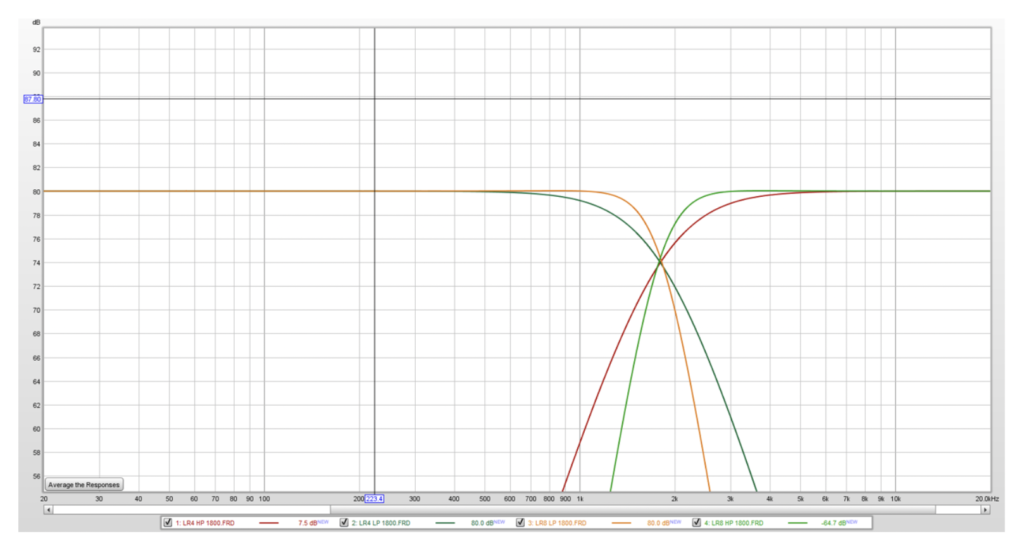Someone asked recently about choosing a crossover slope and asked, specifically, if using a 48dB/octave crossover would provide better protection than a 24dB/octave slope.
I usually recommend 24dB/octave Linkwitz Riley slopes for several reasons. One of those is that if you connect the speakers in the proper polarity according to the markings and set your delays correctly, this crossover sums flat and in phase. That makes things a little simpler than choosing some other combination. In order for this to work, it’s really helpful for the speakers to have useable and reasonably flat response about an octave above or below the crossover.
There’s another reason, though. LR4 (24dB/octave Linkwitz Riley) crossovers provide the most protection for high passed drivers—in addition to being easier and more straightforward to implement (so long as the DSP gives you that choice).
Here are the graphs of LR4 (24dB/oct) and LR8 (48dB/oct).

The 24dB/octave slopes are red and dark green. The 48dB/oct slopes are light green and orange.
When we think about crossovers, we often focus on the slope. 48dB removes power at a faster rate. Well, yeah, once we are well into the downward trend. This is not really the complete picture, though. The vertical scale we’re used to looking at is logarithmic—it’s in dB and this kind of obscures what’s going on the POWER domain.
Every -3dB is reduces power by HALF. -6dB is a quarter of the original power. -12dB is 1/16 of the original power.
So let’s look at the graph below, where I’ve added another scale for power. If we start with 100 watts, the math is simple.

In the first 6dB, the power is reduced by 75 watts. In the second 3dB, the power is reduced by 18.75 watts. In the third 6dB, power is reduced by 4.69 watts and in the last 6dB power is only reduced by 1.17 watts.
So, what happens in the first 6dB has a lot more effect on removing power from the speaker than farther down the slopes. Now look again at the difference between the 24dB/oct crossover and the 48dB/octave crossover.
Hmmm…
There’s a lot more power sent to the speaker around the crossover with the 48dB/octave slope than with the 24dB/octave slope.
Now, if we take this one step further and think about how this is sometimes implemented, it’s an even bigger problem. If we assume that the steep slope allows us to cross our tweeter even lower, we make a BIG mistake.
If we consider pink noise as our reference signal, and we do that because it’s similar to the way power is distributed in actual music, then choosing a crossover one octave lower because we’re using a steeper slope becomes a big problem.
Pink noise is 3dB quieter for every subsequently higher octave. So, in pink noise 500 Hz is 3dB louder than 1kHz. 1kHz is 3dB louder than 2kHz. 2kHz is 3dB louder than 4kHz. 3dB is double the power.
(You can read more about this here: https://www.audiofrog.com/pink-noise-white-noise-and-why-your-tweeters-never-get-150-watts/ )
So, if we reduce our crossover from 4kHz to 2kHz because we are using these steeper slopes, then we’ve now added a LOT more power to our tweeter–roughly 2X the power because we’ve reduced the crossover and another 1.5X (roughly) because of the shape of the crossover at the knee.
So, it isn’t “safer” and it doesn’t really allow us a lower crossover with the same safety.
And this is another reason why LR4 is a really good choice.







